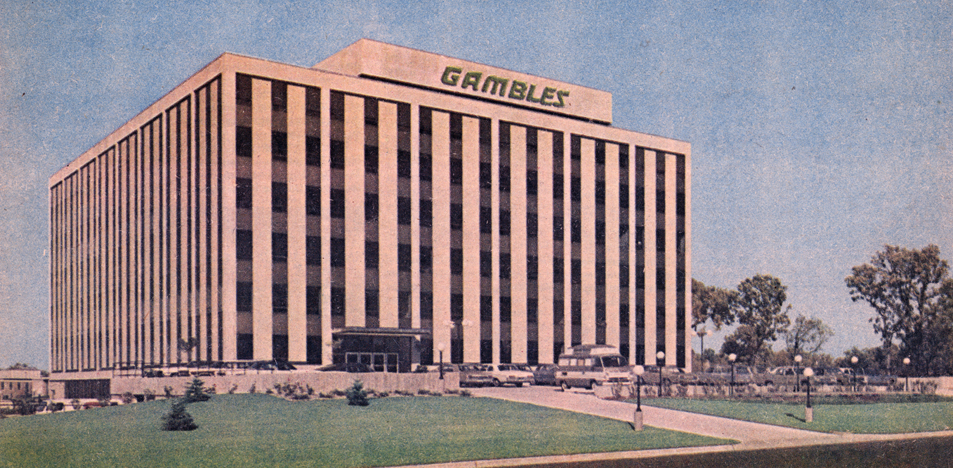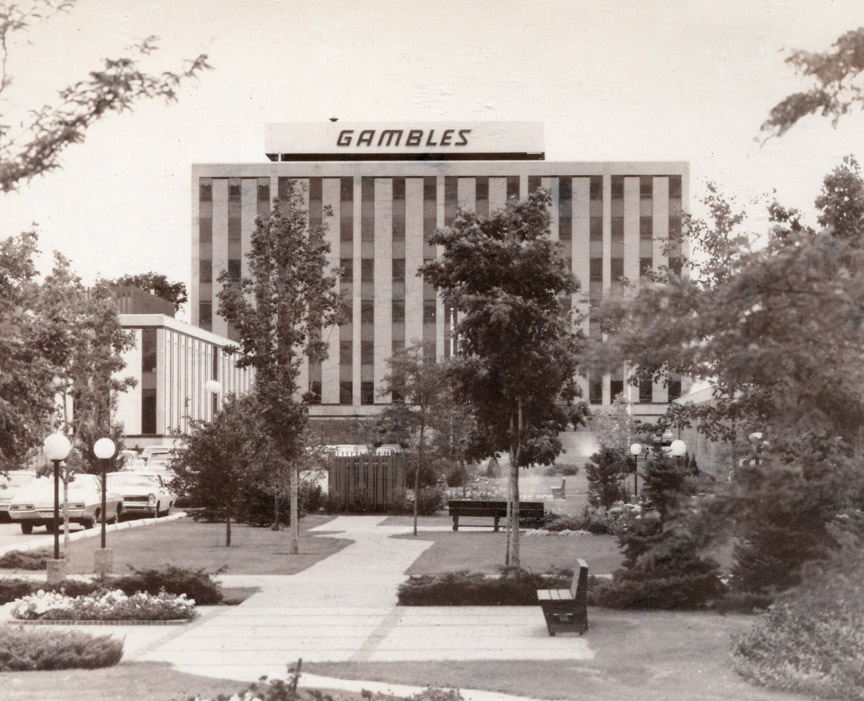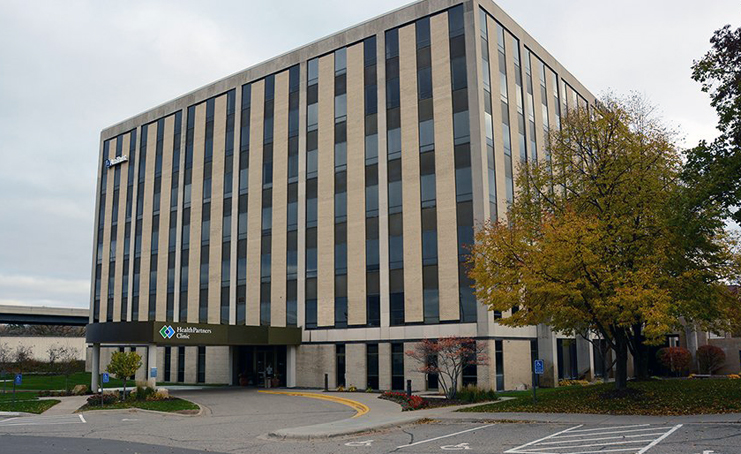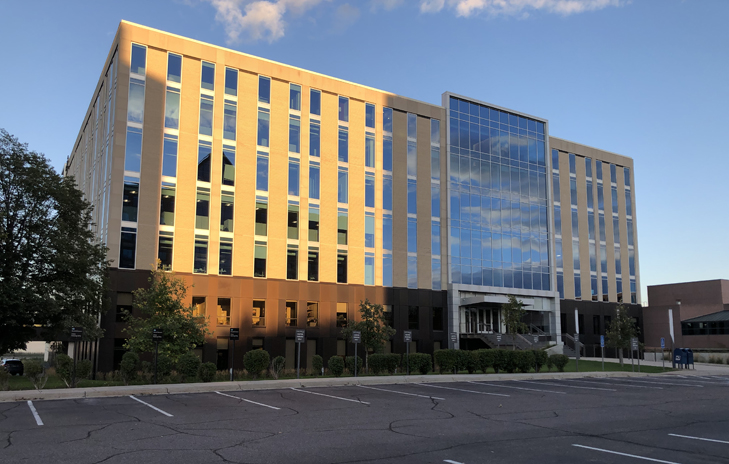GAMBLE-SKOGMO, INC.
Bertin C. Gamble and Phillip W. Skogmo, boyhood friends from Arthur, North Dakota, went to Fergus Falls in March 1920 to open a car dealership. Over time they found that the auto parts business was the most lucrative, and opened the first Gamble Auto Supply Store in 1925 in St. Cloud. Their stores went from selling only auto supplies to housewares, hardware, appliances, etc. From 1925 to 1928 the 55 stores were headquartered in Fergus Falls.
In 1928 the business was incorporated and moved to Minneapolis. From 1928 to 1946 it was located at 700 N. Washington Ave. In 1946 the headquarters moved to 15 North 8th Street (at Hennepin), where it would stay for 22 years.
Philip Skogmo died in 1949.
INTERNATIONAL HEADQUARTERS
On April 4, 1967, Bert Gamble set off a dynamite charge that launched the building of Gamble-Skogmo, Inc.’s $2 million home office building in St. Louis Park. Over 200 people were in attendance at the groundbreaking ceremony, including Minneapolis mayor Arthur Naftalin, Golden Valley mayor Carl Nadasdy, and St. Louis Park mayor Leonoard Thiel. The 7 1/2 acre-site had been Evanoff’s truck gardens. At the time, the firm employed approximately 20,000 people.
Some facts:
- The building’s architect was Baker-Lange
- The builder was announced in 1967 to be Naugle-Leck, although it was later noted that the builder was E.R. Conry Construction Co.
- Employee Goerge C. (Bud) Bohlig was given the job of interior decoration, and he strove to chose decor for each executive office that was “compatible with the personality of the person using the office,” according to a promotional brochure.
- Baker Properties was the named manager of the building
- It was made of 180,000 bricks and 248 tons of stone.
- The building had 200,000 sq. feet of office space.
THE ADDRESS
Over the life of the building, it has had a handful of addresses, or no address at all. Initial descriptions made do with a general “Highway 100 and Highway 12,” since it was accessible from both in those days. City Council notes reveal that the company wanted what is now known as Park Place Blvd. renamed as Gamble Drive. At the time it was called Turner’s Crossroads, which crossed into Golden Valley. A committee was formed, and information stops, but obviously that didn’t happen. Instead, a three-block street leading up to the building from then-Turner’s Crossroads was named Gamble Drive, and although Gambles hasn’t occupied the building since 1982, the street still commemorates its former glory.
Addresses include:
- 5100 Gamble Drive
- 1600 So. Highway 100
- 1665 Utica Ave. So (the current physical and legal address of the building)
NOT JUST A BOX
A “Special Gambles Edition” of Sun Newspapers was issued on November 27 and 29, 1968. It had many stories about the history of Gambles and its subsidiaries, about the lavish furnishings in the new building, and about the just-completed move.

The Open House was December 7, 1968, with Governor Orville Freeman in attendance.
A tour brochure described many lavish furnishings, especially on the sixth floor, reserved for the executives. Features were:
- Paintings
- An imported Italian marble parquet floor
- Matched rosewood wall paneling
- High ceiling in the executive offices
- Hand-carved antique wooden cabinet doors mounted on the wall of the president’s office, imported from Belgium
- Wall hanging comprised of doors of antique cabinets imported from Switzerland and Bavaria
- A 100-year-old rug in Mr. Gambles’ office
- Floor of antique period oak in a Fountainbleau pattern from Kentucky.
- Walls of avodire, an exotic African hardwood
- Hand-carved English fireplace mantle
- Hearth and surround of imported Italian black and gold marble
- Bronze door handles
- Solid brass chandeliers imported from Italy – so heavy that steel beams had to be installed to support them.
- Walls of antiqued bleached mahogany
KLOBUCHAR ON EXECUTIVE TOILET PAPER
In his column in the Minneapolis Star (December 7, 1968), Jim Klobuchar made his usual comic jibes at the splendor:
You may have wondered why it took Gambles so long to put up a building that would reflects its great commercial impact on the country. “The trouble,” one of their public relations operatives explained, “is that it took all this time for us to add up all of our wholly-owned subsidiaries. Frankly, we have envied people like Honeywell, General Mills, 3M and the other Twin Cities business giants because they have got a lot of glamor and showpieces. Now Gambles is huge, you understand, but people just don’t think of us in a glamorous way. I men, how do you glamorize a 29-cent bag of coping saw blades?
“So we moved into this ornate, columned office building, and I leave it to you to say whether this isn’t the most sumptuous, regal and tax-deductible executive quad you have ever seen?”
I cannot really tell you whether it is all of that, but I WAS totally awed by the private quarters of the chairman of the board and the company president. The office of Mr. Burtin C. Gamble, for example, is tastefully expansive in the style of a well-furnished basketball court. It has five easy chairs, a 100-year-old oriental rug (the chairman wanted to know why the company couldn’t afford a new one), a desk that once functioned as the flight deck of the aircraft carrier Forrestal, and a brass bar spanning the window behind he chairman’s swivel chair. “This,” explained the agent, “is to prevent the chairman from falling through the window into the parking lot when he is stunned by our latest profit statements.”
We moved through the ankle-deep carpeting of the executive dining room and conference room, changing time zones when we reached the centering partition.
“Each of the paintings in the executive offices,” the agent continued, “is fashioned to mirror the personality of that particular executive. I think this is something in which all of our loyal employees that particular pride. And for them, of course, we have gathered interesting objects of art from the far corners of the earth, which they can enjoy during the lunch periods in the leisure time that they would otherwise spend on such unfulfilling activities as talking and griping about Joe Kapp.
“Now, we are walking on a unique kind of plush wool carpeting which the designer says will ultimately outlast the skeptics. As you can see, it has a multi-colored, straight-line pattern. I admit it makes you seasick and dazzles you when you look down the lines. As a result, therefore, most of our employees walk cross grain when they go from desk to desk. “This costs us a little in detour time but does save us money that the employee would otherwise spend on Dramamine tablets.”
And now the tour carried us into the marbled sanctuary of the company president’s restroom. I was thunderstruck by the artistic simplicity, the $30,000 worth of marble and stainless steel. But now our gaze fastened on the walls above the fixture, where we stood in fascinated silence, viewing twin spools of Charmin tissue, arranged in neat tandem.
“Remarkable,” I observed, “not one but TWO. I admit I have never been in the presence of such virtuosity.” “Oh, it’s just a little thing,” the agent said modestly. “We thought it the least we could od, a forgiveable little piece of ostentation, right? What do you think about it?”
“I am not sure,” I replied. “But it does tend to confirm one’s lingering suspicions about executives.”

Red Owl became a wholly-owned subsidiary of Gambles in June 1971. In 1977 Bert Gamble retired. At its peak the company had almost 4,200 stores in 38 states, including Gambles Department Stores, Red Owl, and Snyder Drug Stores. The company merged with Wickes Furniture in 1980. Wickes filed for Chapter 11 bankruptcy in April 1982. By July 1982, offices in what was called the Parkdale/Gamble Center Executive Office Complex were being offered for rent. A drawing of five separate buildings was pictured.
HEALTH PARTNERS
In recent times the building has been taken over by Health Partners. The photo below was taken before a major external renovation.

The building is one of the oldest in the so-called “West End,” with apartments now proliferating this northeastern section of our City.

MUSEUM
There was a Gamble Museum in the headquarters building in St. Louis Park that was later moved to the lobby of Walker Methodist Health Center at 3737 Bryant Ave. South in Minneapolis. The museum contains a wide variety of merchandise that was sold in the early Gambles Hardware Stores, along with awards and memorabilia highlighting Mr. Gamble’s merchandising accomplishments and community philanthropic participation.
GAMBLES WAREHOUSE
Gambles also built a nearby warehouse at 5445 Wayzata Blvd. in 1959.
Any additions or corrections to this information are appreciated; please contact us.
